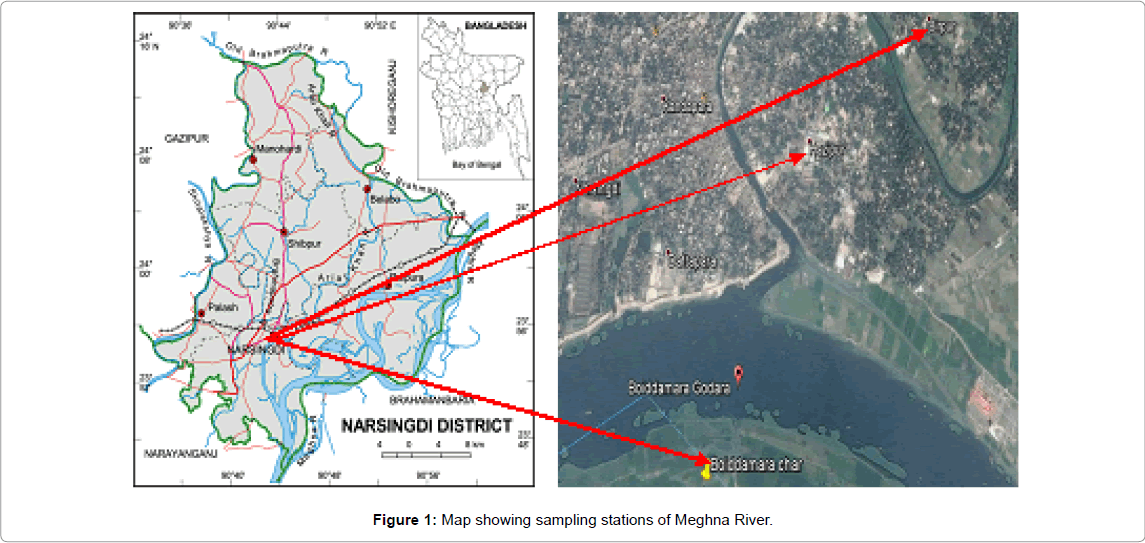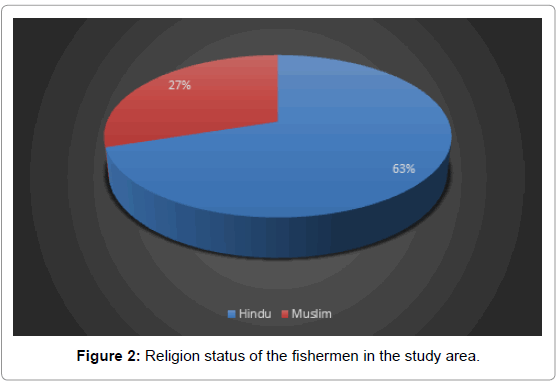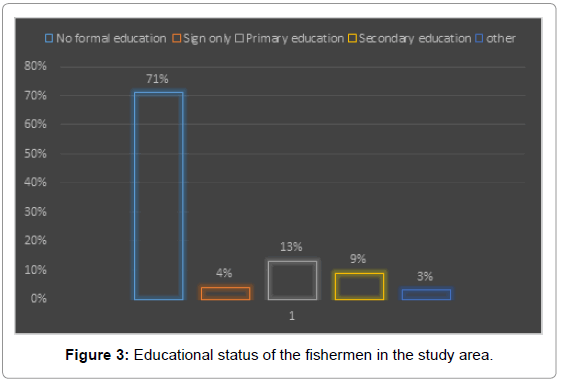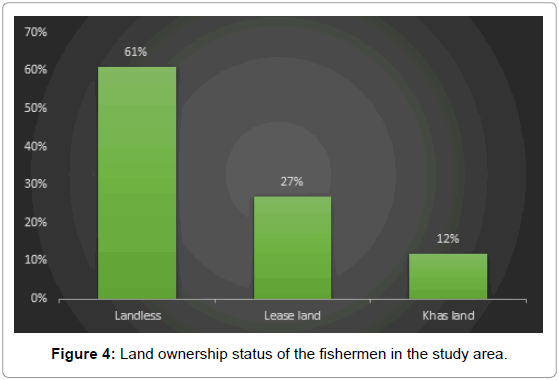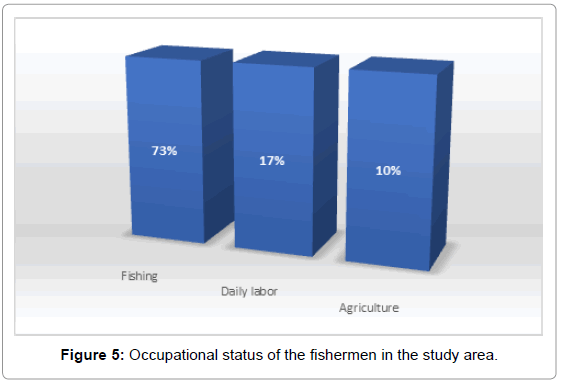Research Article Open Access
Present Status of Socio-economic Conditions of the Fishing Community of the Meghna River Adjacent to Narsingdi District, Bangladesh
Bhuyan S* and Islam SInstitute of Marine Sciences and Fisheries, University of Chittagong, Chittagong, Bangladesh.
- *Corresponding Author:
- Bhuyan S
Institute of Marine Sciences and Fisheries
University of Chittagong
Chittagong, Bangladesh
Tel: +880 1878-914494
E-mail: simulbhuyan@gmail.com
Received Date: June 10, 2016; Accepted Date: June 22, 2016; Published Date: June 30, 2016
Citation: Bhuyan S, Islam S (2016) Present Status of Socio-economic Conditions of the Fishing Community of the Meghna River Adjacent to Narsingdi District, Bangladesh. J Fisheries Livest Prod 4:192. doi: 10.4172/2332-2608.1000192
Copyright: © 2016 Bhuyan S, et al. This is an open-access article distributed under the terms of the Creative Commons Attribution License, which permits unrestricted use, distribution, and reproduction in any medium, provided the original author and source are credited.
Visit for more related articles at Journal of Fisheries & Livestock Production
Abstract
The present study was carried out to assess the livelihood status of traditional fishing community of Meghna River adjacent to Narsingdi District from September 2015 to March 2016. Data were collected through the well-structured questionnaire survey from Noyapara, Daspara, Birpur and Boiddamara char close to Meghna River. A total of 100 fishermen were selected randomly for interview. The findings of the study revealed some interesting facts and showed most of the fishermen were Hindu (63%) belong to the age of 24-45 years. Almost 71% of the fishermen were illiterate and got medical help mainly from village doctor (80%). It was found from the investigation that most of the house were kacha (65%) and with poor sanitation facilities. For coping with adverse situation most of them (85%) take loan from somiti (Asha). There was a prevalent relationship of contentment of fishermen, children’s school, taking risk at work, electricity facilities and medical facilities with the fishing income that was analyzed by One Way ANOVA (SPSS v.22) as the alpha level (p < 0.05). Principal Component Analysis (PCA) was done to isolate variables that may be sufficient for socio-economic study and Correlation matrix was done to find out the relation among variables.
Keywords
Socio-economic; Conditions; Fishing community; Meghna river; Correlation matrix
Introduction
Predominantly, Bangladesh popularly known as 'land of rivers' [1] and cress-crossed by hundreds of rivers rich with marine and fresh water resources [2]. There are about 230 rivers and estimated total length of rivers, streams and canals altogether cover more than 24,000 km [3]. Interestingly, riverine fishing areas include approximately one fifth of the entire fishing area of 4.9 million ha of the country [4] that may be considered as dynamic component of the agro-ecosystem of Bangladesh [5]. Moreover, about 12 million people directly or indirectly associated with fishing activities for their livelihood [6]. For subsistence level fishermen and their families, the fish they catch is often their only source of protein and essential minerals [7]. Fishermen, the essential but the most vulnerable communities live below the poverty line and their livelihood standard is deteriorating with times in Bangladesh. Fisheries sector plays a crucial role in the national economy of Bangladesh through employment generation, poverty alleviation, supply of animal protein and foreign exchange earnings [8]. It provides 1.78 million people’s full-time and part-time employment facilities [9]. This sector also contributes about 60% of the national animal protein in-take and 19% percent of the total protein intake in the average Bangladeshi diet [10]. Furthermore, this sector adds about 2.46% of the total export earning, 4.39% to GDP and 22.76% to agrarian sector. Yearbook fish production was 3.26 million metric tons in the fiscal year 2011-2012 [11] and estimated income was about 70% lower than the per capita income stated by Alam and Bashar [12]. Ironically, Ahmed and Reazuddin [13] reported that some of the rivers have become biologically and hydrologically dead due to haphazard discharge of domestic sewage, industrial wastes and agricultural inputs. Chambers & Conway [14] stated that, livelihood is defensible when it can cope with stresses & shocks and enhance its competences to recover from it. Different approaches had been adopted for sustainable rural development and poverty elimination [15]. Scoones reported that, to eradicate poverty sustainable livelihood is a way of thinking about the ideas, scope and priorities for development [16].
Meghna River close to Narsingdi district is being polluted and industries are the great contributor of wastages. The effluent from these industries severely affecting the aquatic organisms and declining fish hugely. In some cases, the waters bodies of the river endowed with no fish because of heavy pollution. Unfortunately, there was no systematic research on the livelihood status of this region. For sustainable management of natural resources and building capacity, participation of fishermen needed badly [17-20]. Sustainable and marginalized development of the fishermen largely rely on successful management of water resources.
Materials and Methods
Study area
The present study was carried out at Noyapara, Daspara, Birpur and Boiddamara char in Meghna River nearer to Narsingdi district (2°55'28.52"N and 90°45'12.06"E). The survey was conducted from September 2015 to March 2016. All the people of these area are somehow more or less involve with the fishing. Meghna River plays an important role in the improvement of the present life style of fishermen (Figure 1).
Data collection
Data was collected data using surveys, focus groups, PRA (Participatory Rapid Appraisal), RRA (Rapid Rural Appraisal), key informant interviews and direct observations. Questionnaire survey was done for this study and interviewees were selected randomly [21]. The survey design was based on expert advice from local NGO staff and guidelines for collecting baseline fisheries data [22]. To get income and demographic data we used the design drew on regional guidelines [23] and validity recommendations [24].
Data analysis
One Way Analysis of Variance (ANOVA) was done to show the relationship among the variable. According to [25], Principal Component Analysis (PCA) was performed on the original data set (without any weighting or standardization). Pearson’s product moment correlation matrix was done to identify the relation among variables to make the result strong obtained from multivariate analysis.
Results and Discussion
The present study was carried out to evaluate the livelihood standard of the fishing community of Meghna River. From the study, it was observed that there was a prevalent relationship of contentment of fishermen, children’s school, taking risk at work, electricity facilities and medical facilities with the fishing income that was analyzed by One Way Analysis of Variance as the alpha level (p < 0.05).
Human capital
In the present research findings, 63% fishermen were Hindu whereas the rest belong to the Muslim (27%) similar to [26-28]. Kabir, [29] found 82% Hindus and the rest 18% Muslims (Figure 2) at fishermen community of Old Brahmaputra River. Hannan [30] reported that, fisherman used to catch fish came from a low caste of Hindu society and most of them are affected by caste system [31].
Mainly men (86%) are directly involved with fishing and female (14%) incorporate in fishing. More or less similar result found Das, et al. [26] and DoF [32]. Result of the present study indicate that most of the fishermen belong to the age group of 24-45 years (45%). Similar result found by Minar [33] who conducted research in Kirtonkhola River nearby to the Barisal town. In the recent findings, it was found that most of the family comprises of 5-6 family members similar to [27,29]. Most of the family prefer single family (81%) because of poverty. This result more or less similar to the result found by [26,27,29,34,35]. Unfortunately, 71% of the fishermen are illiterate while only 4% can sign only (Figure 3).
This result completely acquiesced with the result of Hossain & Pingali [36] and Shahjahan et al. [37] reported that majority of the fishermen were uneducated (71.12% and 63.33% respectively) while 24.44%, 31.67% of the riverine fishermen had only primary level of education and only 4.44%, 5% of them had only secondary level of education respectively. According to Hannan [30], most of the fishermen (96.97%) were literate at the multiple phases of education among the coastal fishing community of the Kalapara Upazilla. Ahamed [38] found literacy rates 25% and 23% respectively in the polder estuaries. DoF [32] in chanda beel and Ahamed [39] in Tangail recorded literacy rates 45% and 69% respectively.
Natural capital
The natural capital of the fishermen characterizes the resources such as land, water, timber, wildlife, biodiversity, environmental resources [29]. These resources are essential for fishermen and related groups to support yield [35]. Unplanned and rapid growth of population affected fishermen income that hugely responsible for capital depletion.
Physical capital
It was found from the investigation that most of the fishermen were landless (61%) (Figure 4) and houses were mostly kacha (65%).
Ahamed [39] reported that 94% fishermen dwell in their own house while Mannu [40] reported that 28% of fishermen built house on the khal land. Alam and Bashar [12] documented about 82.22% of household arrangements were kancha of the Basantapur beel fishermen.
In the investigated area, it was found that health facilities was very poor and most of them (80%) relied on village doctor (quack). That result quite above the Ali et al. [35] and Kabir et al. [29]. Fishermen were experienced with various diseases like fever (50%), skin diseases (32%), cold, diarrhoea, jaundice, and typhoid etc. due to most probably the polluted water of the river and poor sanitary condition. Shamima [28] reported that 52% fishermen suffered from fever in Gollamari fishing communities, Khulna District. Access to the clean and safe drinking water is regarded as the most important fundamentals in the society. In the recent study it was found that 100% of fishermen households used tube-wells water for drinking purposes (Figure 5) and among them 52% fishermen used their own tube-well, 48% fishermen used neighbors tube-well. This scenario was quite common among the fishermen in most areas of Bangladesh and similar results were documented by Alam and Bashar [12]. Almost 65% latrin were Kacha in the studied area making the health condition worsen. This study revealed that the sanitary conditions of the fishermen were not so well. Ali et al. [35] reported that 62.5% of the farmers had semi-paka and 25% had kacha in some selected areas of Tarakanda upazila of Mymensingh district. Almost 52% fishermen have access to the electricity which was above the result found by Shamima [28] and DoF [41,42].
Financial capital
Most of the fishermen dwelling close to the Meghna River adjacent to Narsingdi district engaged in fishing as their principal occupation (73%). Nevertheless, some were engaged in agriculture (17%) and day labor (10%) as their core occupation (Figure 5).
The findings of the present study were more or less similar to the results found by Kabir et al. [29] and Alam and Bashar [12]. Majority of the fishermen possessed no land and completely depended on physical labor. They live by catching fishes during rainy season or engage themselves in other kind of economic activities during dry season. Most of the fishermen have no fixed income and income varies from time to time. The annual income of the subsistence level fishermen ranged from (40000-60000 BDT) (72%). In Northeast Nigeria, About 42% to 70% of rural households who are dependent on fishing in Northeast Nigeria that contribute 24-28% of their income. During the odd situation, they overcome the financial crisis by taking loan from somiti (45%), some of them take loan from NGO (12%) and relatives (10%). This result similar to the findings of Baki et al. [27] and Alam Alam and Bashar [12].
Correlation matrix
In livelihood assessment, the inter relationship among variables provide insight about the relationship among variables. The result of correlations between variables acquiesced with the results obtained by PCA and CA that confirm some new relations among parameters. There was significant positive correlation between Lengths of service vs Age of the respondent (0.829), Number of children vs Number of family members (0.744). moderate positive correlation between Number of children vs Age of the respondent (0.540), Children going to school vs Sole earning member of the family (0.523), and weak correlation exist between Is fishing main income source vs Number of family members (0.495), Receive advance money vs Sole earning member of the family (0.345), Satisfaction with present financial benefits vs Satisfaction level in present socio-economic condition (0.321), Type of garden produces vs Having livestock (0.351). On the other hand, moderate negative correlations were found between Children going to school vs. Sole earning member of the family (-0.619), Sole earning member of the family vs. Length of service (-0.541).
Principal component analysis
The extraction method was used to find out the principal components in PCA analysis that was Eigen values. The components were taken as principal components whose Eigen values was greater than 0.5 were taken into account. 13 PCs were extracted by using correlation matrix. Sole earning member of the family and Children going to school are belong to PC1. PC2 was declining of catch year to year, Membership to association and PC3 was having livestock. Legal help from police (PC4), source of weather forecast at river (PC5), coping mechanism for declining fish catch and Superstition regarding safety at sea (PC6), having saving schemes (PC7), life insurance can reduce risk (PC8), satisfaction with present financial benefits (PC9), common coping strategies for financial difficulties (PC10), life insurance can reduce risk (PC11), having gold jewelry (PC12), Sources of loan available (PC13).
Nets Used for fishing
The net mostly used in fishing in the study area were Current jal, Ber jal, Thella jal, Jhaki jal, Dharma jal, Borshi etc in the Meghna River. Similar net patterns were used in the old Brahmaputra river region by the fishermen reported by Kabir et al. [29].
Limitations towards socio economic development
Illiteracy, population pressure, low economic status and river pollution are the main problems towards Socio economic development for the Meghna river fishermen community. Most of them are illiterate and their children have to detach from school as they live from hand to mouth. Fishermen live below the poverty line from generation to generation and struggle for existence not for develop their condition. In fishermen community, women play role in making diverse types of fishing materials, rearing children, household activities and sometimes in harvesting fish. Both male and female work hard but their socioeconomic condition remain same or become worse than past.
Conclusion and Recommendation
The present study was conducted to assess the socio-economic condition of fishermen living in Noyapara, Daspara, Birpur and Boiddamara char nearby Meghna River located at Narsingdi district. The objective of this study was to know the socio-economic condition of fishermen in the selected area. The fishing communities of the study area were found to belong to disadvantaged group. They are the people of lower economic strata. The monthly income per fishermen was comparatively lower from the national per capita income. On the whole life the fishermen are risk and their live have no refreshment. Their social status is very low. From the findings of the study, the following recommendations can be made to improve the socio-economic condition of the fishermen and thereby improve their well fare.
• Pollution from industries must be controlled.
• Educational institution should be set up in fishing villages to improve their educational status.
• Government should give loans for them at a low interest rate and create alternative job opportunity in off peak season.
• Local government, NGOs should play a vital role for improving sanitation system.
• Increase of public awareness through the various publications and publicity for protecting fishery resources should be done.
• Organization of fishery co-operative society should be done.
• The fishermen should be encouraged to sell their fish to the market directly without involvement of the intermediaries.
References
- Bundell K, Maybin E (1996) After the prawn rush: the human and environmental costs of commercial prawn farming. Christian Aid Report, London.
- Rahman AKA (1994) Country report on socio-economic issues in coastal fisheries management in Bangladesh. In: Socio-economic Issues in Coastal Fisheries Management, Proceedings of IPFC Symposium, Bangkok, Thailand, FAO Indo Pacific Fishery Commission 8: 170-175.
- Rashid H (1991) Geography of Bangladesh (Second Revised Edition), University Press Limited, Dhaka, Bangladesh 529.
- Huq A, Khan MS, Huq M, Dey HK, Alam SMN, et al. (1986) Socioeconomic Study of Typical Fishing Community in Bangladesh. A Report Prepared for the Food and Agricultural Organisation (FAO), Rome, Department of Economics, University of Chittagong, Bangladesh: 1-10.
- Sadeque SZ (1990) Capture fisheries and other common property resources in the flood plains of Bangladesh. Journal of social studies 55: 20-34.
- DoF (2005) Fisheries Fortnight Compendium, Department of Fisheries, Ministry of Fisheries and livestock, Dhaka, Bangladesh.
- Rahman MA, Mondol MN, Hannan MA, Habib KA (2015) Present Status of Fish Biodiversity in Talma River at Northern Part of Bangladesh. International Journal of Fisheries and Aquatic Studies 3: 341-348.
- Alam MJ (2005) Socio-economic conditions of haor fishermen a field level study. BRAC university journal 2: 57- 63.
- Azad SA (2015) Fisheries sector in socio-economic development of Bangladesh. National Fish Week 2015 compendium (In Bengali), Department of Fisheries, Ministry of Fisheries and Livestock, Bangladesh: 13-23.
- DoF (2014) Compendium (In Bengali), Department of Fisheries, Ministry of Fisheries and Livestock, Bangladesh: 144.
- DoF (2013) National Fish Week 2013 Compendium (In Bengali) Ministry of Fisheries and Livestock, Bangladesh: 144.
- Alam MF, Bashar MA (1995) Structure of cost and profitability of small scale riverine fishing in Bangladesh. Journal of Research Progress 9: 235-241.
- Ahmed AU, Reazuddin M (2000) Industrial Pollution of Water Systems in Bangladesh, University Press Limited, Dhaka, Bangladesh: 175-178
- Chambers R, Conway (1992) Sustainable Rural Livelihoods: Practical Concept for the 21st century, Discussion paper: 296.
- DFID (1999) Sustainable livelihoods guidance sheets, (DFID), London, UK.
- Scones I (1998) Sustainable rural livelihoods: a frame work for analysis. IDS working paper No. 72. Brighton: IDS, UK.
- Agarwal B (2001) Participatory exclusions, community forestry, and gender: an analysis for South Asia and a conceptual framework. World Development 29: 1623-1648.
- Agrawal A, Gupta K (2005) Decentralization and participation: the governance of common pool resources in Nepal's Terai. World Development 33: 1101-1114.
- Bhandari BS, Grant M (2007) Analysis of livelihood security: a case study in the Kali-Khola watershed of Nepal. Journal of Environmental Management 85: 17-26.
- Rew A, Rew M (2003) Development models âÂ?Â?Out-of Place: social research on methods to improve livelihoods in eastern India. Community Development Journal 38: 213-224.
- Henry GT (1990) Practical Sampling. SAGE Publications, Newbury Park, CA, USA
- Kronen M, Stacey N, Holland P, Magron F, Power M (2007) Socioeconomic Fisheries Surveys in Pacific Islands: A Manual for the Collection of a Minimum Dataset. Secretariat of the Pacific Community (SPC), Noumea, New Caledonia.
- King MD, Glass A, Wanyonyi I, Bunce L, Pomeroy B (2006) Socioeconomic monitoring guidelines for coastal managers of the Western Indian Ocean. In: Coral Reef Degradation in the Indian Ocean (CORDIO East Africa).
- Fink A (2003) The Survey Kit, 2nd ed. SAGE Publications, Thousand Oaks, CA, USA.
- Dreher T (2003) Evaluation of graphical and multivariate methods for classification of water chemistry data. Hydrogeology Journal 11: 605-606.
- Das MR, Roy S, Kumar U, Begum S, Tarafder SR (2015) Livelihood assessment of the fishermen community in the south west region of Bangladesh. Journal of Experimental Biology and Agricultural Sciences 3: 353-361.
- Baki MA, Islam MR, Hossain MM, Bhouiyan NA (2015) Livelihood status and assessment of fishing community in adjacent area of Turag-Buriganga River, Dhaka, Bangladesh. International Journal of Pure and Applied Zoology 3: 347-353.
- Shamima A (2000) Socio-economic conditions of fishing community: Gallamary fish market, Khulna. A project thesis in Fisheries and Marine Resource Technology Discipline, Khulna University, Khulna, Bangladesh: 11-34.
- Kabir KMR, Adhikary RK, Hossain MB, Minar MH (2012) Livelihood Status of Fishermen of the Old Brahmaputra River, Bangladesh. World Applied Sciences Journal 16: 869-873.
- Hannan M (1994) Fisherfolk organization in Bangladesh. In: Socio-economic Issues in Coastal Fisheries Management. Proceedings of the IPFC Symposium, Bangkok, Thailand, FAO Indo-Pacific Fishery Commission (IPFC) 8: 216-222.
- Oudwater, Nicoline (2001) The Sustainable Livelihoods Approach and its Relevance for Marketing, Paper presented in the inception workshop on Poverty Alleviation and Livelihood.
- DoF (1993) Ministry of Fisheries and Livestock, Dhaka, Bangladesh. National Fish Week Compendium (in Bengali): 144.
- Minar MH, Arifur AFMR, Anisuzzaman M (2012) Livelihood status of the fisherman of the Kirtonkhola River nearby to the Barisal town. Journal of Agroforestry and Environment 6: 115-118.
- Ali H, Azad MAK, Anisuzzaman M, Chowdhury MMR, Hoque M, et al. (2009) Livelihood status of the fish farmers in some selected areas of Tarakandaupazila of Mymensingh district. J Agrofor Environ 3: 85-89.
- Hossain M, Pingali PL (1998) Rice research, technological progress and impact on productivity and poverty: an overview. In: Pingali P, Hossain M (eds.) Impact of Rice Research. Proceedings of the International Conference on the Impact of Rice Research,Bangkok. Thailand: Thailand Development Research Institute and Los Benos (Philippines) and IRRI: 1-2.
- Shahjahan M, Miah MI, Haque MM (2001) Present Status of Fisheries in the Jamuna River. Pakistan Journal of Biological Sciences 4: 1173-1176.
- Ahamed N (1999) A study on socio-economic aspects of coastal fishermen in Bangladesh.Journal of Zoology 24: 20-26.
- Ahamed NU (1996) Reports of the fishermenâÂ?Â?s socioeconomic survey. Fisheries survey and monitoring program. Department of fisheries, Bangail: 4.
- Mannu MU (1999) JelederSukhDukh. The Daily Janakantha.
- DoF (2012) Ministry of Fisheries and Livestock, Dhaka, Bangladesh. National Fish Week Compendium (in Bengali): 144.
- Neiland AE, Sarch MT, Madakan S, Ladu B, Jaffry, et al. (1994) A socio-economic analysis of artisanal fisheries in North East Nigeria. Portsmouth, CEMARE, University of Portsmouth: 222-256.
- Hossain MM, Baki MA (2014) Freshwater habitats and fishing activities in the Buriganga River, Dhaka, Bangladesh. HydroMedit Volos, Greece: 318-323.
Relevant Topics
- Acoustic Survey
- Animal Husbandry
- Aquaculture Developement
- Bioacoustics
- Biological Diversity
- Dropline
- Fisheries
- Fisheries Management
- Fishing Vessel
- Gillnet
- Jigging
- Livestock Nutrition
- Livestock Production
- Marine
- Marine Fish
- Maritime Policy
- Pelagic Fish
- Poultry
- Sustainable fishery
- Sustainable Fishing
- Trawling
Recommended Journals
Article Tools
Article Usage
- Total views: 14766
- [From(publication date):
December-2016 - Aug 18, 2025] - Breakdown by view type
- HTML page views : 12952
- PDF downloads : 1814

